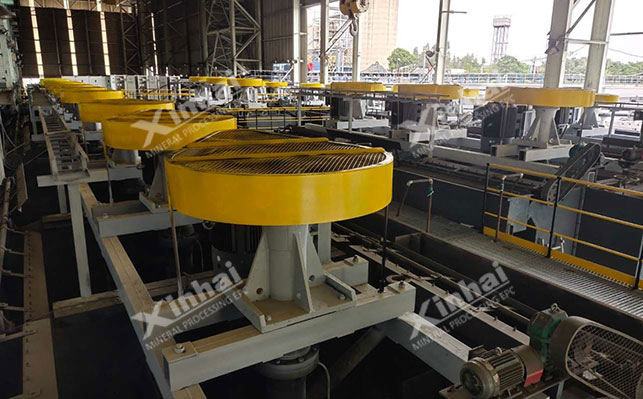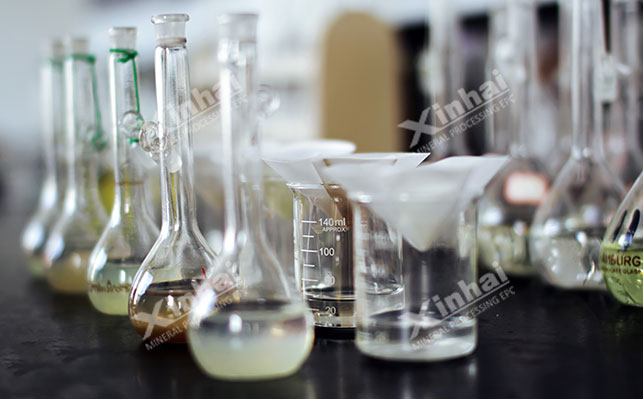
15311826613
Click to add WeChatPhosphorus is an important raw material in industrial fields such as phosphate fertilizers, medicine, food, dyes, sugar, ceramics, and national defense. The main source of phosphorus is phosphate rock. my country's phosphate rocks are mainly medium-sedimentary phosphate rock deposits. This type of phosphorus Most of the mineral resources are medium and low-grade ores with high silicon and magnesium impurity content, and the useful minerals are generally closely combined with the gangue minerals. The embedded particles are fine, in the form of homogeneous colloids or cryptocrystalline or microcrystalline materials, which are difficult to decompose. Generally, the grinding fineness needs to reach -200 mesh and the mass fraction is greater than 90% in order for the monomer to be dissociated. Therefore, flotation is often used as the main beneficiation scheme. Let’s take a look at the common phosphate rock flotation methods and commonly used flotation reagents.

At present, the commonly used methods for flotation of colloidal phosphate rock in my country include forward flotation and forward and reverse combined flotation.
The positive flotation process has strong adaptability to the fine-grained silica-calcium collophosphate rock. This is because the floatability of siliceous gangue and calcareous collophosphate rock is very different. It can be easily achieved by using a suitable chemical system. Good separation of useful minerals and gangue minerals. The positive flotation process is simple and has high impurity separation efficiency. The process is to first grind the phosphate rock until the monomers are dissociated, add water to the slurry to adjust it to a certain concentration, use a specific collector to enrich the useful phosphorus minerals in the foam product, and use specific agents to inhibit the phosphate minerals in the phosphate rock. Gangue minerals such as silicate and carbonate.
However, domestic phosphate rock has a high carbonate content, and the floatability of carbonate is similar to that of apatite. When silicate minerals and carbonate minerals appear at the same time, the quality of positive flotation process products is often not high.

As the properties of colloidal phosphate ore continue to change, it is difficult to obtain qualified phosphate concentrate using the forward flotation process alone, let alone high-quality phosphate concentrate. Therefore, a combined process of forward flotation and reverse flotation can be used. to process colloidal phosphate rock. During flotation, the combined method needs to be selected based on the properties of the phosphate rock. Common combined methods include forward-reverse flotation, reverse-forward flotation, double reverse flotation and double reverse-forward flotation processes.
Anyway, flotation: use mixed acid (sulfuric acid:phosphoric acid-2:1) as pH adjuster and phosphorus mineral inhibitor, HY-1 as carbonate collector to remove carbonate by reverse flotation, and then use NaOH and Sodium carbonate is used as pH adjuster, water glass and sodium hexametaphosphate are used as silicate mineral inhibitors, and HP-1 is used as phosphate collector to obtain phosphate concentrate through flotation.
Forward and reverse flotation: When the fine particle size of the silica-calcium collophosphate ore is wrapped and connected with the gangue minerals, the forward and reverse flotation process can be used. During the forward flotation, sodium carbonate and water glass combined inhibitors are used to strengthen it. Colloidal phosphate and silicate minerals are sorted. During reverse flotation, PA-64 is used as a carbonate mineral collector to remove oxidized minerals.
Reverse reverse flotation: first reverse flotation of carbonate, then desliming to remove some impurities, and then removing silicate in reverse flotation. The reverse flotation carbonate mineral collector is code-named PA-31.
Flotation: Since my country's phosphate rock gangue minerals are mainly carbonate and silicate minerals, and phosphate rocks in a few areas also contain carbonaceous and sulfide minerals, flotation is a process of reverse flotation. On the basis of flotation, positive flotation is added, whose purpose is to remove carbonaceous ores or sulfide ores in minerals. The process can first use reverse flotation of kerosene to deslim and remove carbon, then use mixed acid of sulfuric acid and phosphoric acid as the adjuster and inhibitor for reverse flotation to remove carbonate, and modified fatty acid HQ as the collector to reverse flotation to remove carbonate. Finally, water glass is used to inhibit silicate, carboxymethyl cellulose inhibitor (S-2) inhibits carbonate, and fatty acid soap S-1 floats to capture apatite to obtain phosphate concentrate.
In the early days, the flotation reagents commonly used in phosphate mineral processing plants were mostly oleic acid, fatty acids, primary amines, water glass, etc. These reagents had poor selectivity and high consumption. With the continuous research and innovation of technical personnel, more and more chemicals are used in phosphate rock flotation. Currently, there are anion collectors and cation collectors.

Commonly used anion collectors for colloidal phosphate rock are fatty acids and their saponification products. These collectors have poor selectivity, are not resistant to low temperatures, and are sensitive to metal ions in slimes and slurries. Therefore, mineral processing workers have been looking for alternatives. In recent years, hydroxamic acid, sulfonate, and phosphate anionic collectors have been gradually used in the flotation process of colloidal phosphate rock.
Cationic collectors are mainly used for reverse flotation to remove siliceous gangue from colloidal phosphate ore. This type of flotation process is widely used abroad, especially for reverse flotation of iron ore. Commonly used amine collectors abroad are mainly amides, ether amines, polyamines, etc.

The above is an introduction to the colloidal phosphate rock flotation process and flotation reagents. In an actual mineral processing plant, how to choose the flotation process and reagents depends on the properties of the colloidal phosphate rock ore. Therefore, mineral processing tests and analysis are required. Through analysis, Only by designing a suitable colloidal phosphate ore beneficiation process plan and reasonable chemical types can we obtain an ideal return on investment.